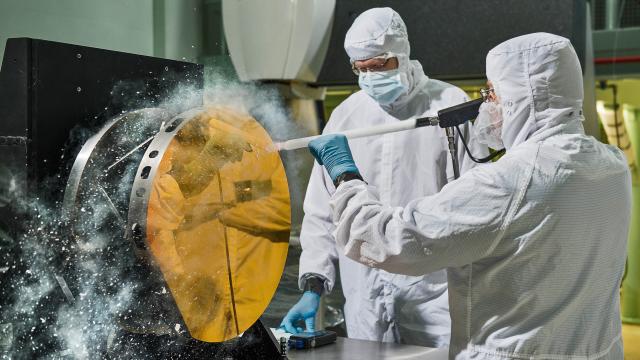The House Committee on Science, Space and Technology has concluded two days of hearings focused on trying to understand how the James Webb Space Telescope — NASA’s flagship telescope project — could have gone from a 2007 planned launch with a $US500 ($673) million budget to a 2021 launch with a $US9.6 ($13) billion budget.
The discussion was mostly subdued, with many of the questioners reaffirming their support for the mission as well as for the actions recommended by a recent independent review. But tensions rose during the testimony of Northrop Grumman CEO Wes Bush, in which he refused to disclose his company’s 2017 profit aloud with Congressman Lamar Smith (R-Texas), offering documentation for the record instead.
“How could a CEO not know what the profit of the company was last year?” Smith said.
The James Webb Space Telescope promises to be Hubble’s incredible successor. It will sit at L2, a gravitationally stable point a 1.6 million kilometres from Earth where the telescope can maintain the same position relative to our planet and the Sun.
Its budget has repeatedly ballooned and its launch date has been pushed back several times as the project’s goals became more ambitious and unexpected issues turned up. Most recently, testing setbacks, with a healthy portion of human error, have pushed the projected launch date from May 2020 to March 2021. The project will require another $US800 ($1076) million dollars.
Much of the budget overruns come from overoptimism related to the project, as we detail here. But Smith laid the blame for some of the most-discussed of these human errors on NASA’s contractor, Northrop Grumman.
In one case, the company used the wrong solvent to clean valves in the telescope’s thrusters, destroying some equipment. He said that the lack of individual safety checks lead to problems and errors that didn’t appear until testing. A recent Independent Review Board, led by former director of NASA’s Goddard Space Flight Center Tom Young, recently released a report with a series of recommendations for the team to look for other potential errors, perform testing and complete the project.
Bush said that Northrop Grumman would adhere to the recommendations in the independent review. Additionally, he said that all payments already received and to be received in the future for the contract would be placed into a holding account and would only be released to his company if the mission is successful.
But when Smith asked what Northrop Grumman’s 2017 profit was to the nearest billion dollars, Bush would not say (it’s $US2.015 billion). When Congressman Smith asked if Northrop Grumman would pay the $US800 ($1076) million that the project is expected to go over, Bush said the company would not.
Gizmodo reached out to Northrop Grumman for comment and will update the post when we hear back.
NASA maintains some of the responsibility for the project’s changing plan. “We can blame the contractor, but it is on us to have mission success”, NASA Director Jim Bridenstine said at the hearing.
Despite these challenges, members of Congress are clearly still excited about the flagship mission, with several expressing their eagerness to show the world what American science can do. Many were sympathetic to just how much science has changed — astronomers have found thousands of exoplanets since the project’s kickoff and the mysteries of dark matter and dark energy have only deepened.
Still, several remained angry about the project. Congressman Dana Rohrabacher (R-California) asked about whether there were possible penalties for Northrop Grumman and suggested these delays be taken into account when NASA is assessing future contracts.
Others asked that future project plans include better stopgaps so that errors are noticed before integrated testing.
NASA is also grappling with the effect of these budgetary overruns. At the hearing yesterday, NASA Director Bridenstine said there have been discussions, but not decisions, as to how JWST will “cannibalise” other missions. He mentioned delaying the upcoming WFIRST telescope as a possibility, but said that the needed funding would not come from human spaceflight endeavours.
There’s still plenty of work to do before what will hopefully be a March 2021 launch. Bridenstine mentioned 300 potential points of failure that will require testing and an optimistic schedule. And since the telescope is going to be at L2, rather orbiting close to Earth, you can’t easily go back to fix it if something goes wrong, the way Hubble needed a quick fix after its own deployment.
Still, despite the huge cost and discouraging delays, it’s going to be an incredible telescope, as per every astronomer Gizmodo has spoken to about the mission. It will be able to explore the Universe’s extremes and perhaps discover things we haven’t even thought to question yet.
It just needs to get off the ground.
